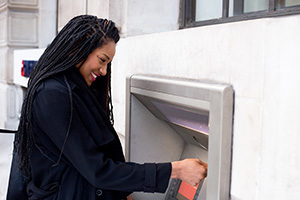Compare savings accounts at U.S. Bank.
Get competitive rates, plus features and benefits to help you manage your finances.
Updated April 10, 2025 | 3 min. read
If saving for a down payment feels intimidating—or if you just want to get smarter about it—U.S. Bank Client Relationship Specialist Holly Rae Kevelin [NMLS ID: 520557] and Branch Manager Jason Dean Namyst [NMLS ID: 1530787] can help you make the most of your money. Holly and Jason often guide their clients through their down payment journeys with some strategic moves you might not have thought of.
There are a few types of accounts you can choose from when you’re saving for a big purchase: a savings account, or a certificate of deposit (CD). A savings account lets you withdraw money and earn a bit of interest on the funds in the account. A CD also acts as a deposit account, but often earns you higher interest. The main difference is that you can’t withdraw funds from a CD before the account has reached its “maturity” — if you do, you’ll incur an early withdrawal penalty.
Choosing between a savings account and a CD usually depends on how soon you want to purchase your home. If you’re looking to buy a few years down the line, adding money to a CD where it can earn interest as you continue to save is a viable option. “If the savings account you’re considering is dependent on a very minimal yield, I would recommend looking at CDs instead,” says Jason. “You can do things like add your tax return to it and watch your money grow slowly over time, without missing the funds.”1
There are many more ways to save besides skipping the takeout and cutting out unnecessary purchases. Depending on your risk tolerance, you can put some of your money in the market and see how it grows. “Some people will place a portion of their money in the market to make additional gains that they normally wouldn’t have access to,” Jason says. “You can work with a Investments Connect Advisor to look for products that may suite your needs.”
Both Holly and Jason encourage people in money-saving mode to remain diligent and always keep their goal in mind — especially if it doesn’t come naturally. “If you struggle with savings, place a debit block on your savings account by speaking with a banker, then set up automatic deposit from your paycheck or other account so your savings become automated, by doing this you can only withdraw from savings if you come into the bank” says Jason. The U.S. Bank mobile app has options to keep you extra aware of your spending and saving. Holly recommends you set alerts for your purchases and transfers, so you can see what’s going in and out of your accounts in real time. If you use the in-app savings goal tool, you can turn on notifications for when you earn “badges” for getting closer to your goal. The app can help you set and track your goals with personalized advice to help you plan for the future. And, when you’re ready to apply for a mortgage, you can do so right within the app.
Holly and Jason even have solutions when saving seems like it has to be put on hold. For example, unexpectedly having to get a new car: “Look at lots of options when you think you have to make a big purchase,” Jason says. “Evaluate your options — you might want to spend a big chunk to fix your car instead of paying for a new car. Buying that new car may prevent you from qualifying for that new home, because now you are carrying new type of debt on your credit report.” Being strategic when unexpected expenses come up can help you avoid setbacks and stay on track.
As soon as you decide to take the plunge into homebuying, start saving, but don’t forget to ask a pro for their opinion on how you’re positioned. “Have a conversation with a mortgage loan officer,” Holly says. “Sometimes, clients might be setting themselves a goal, but they don’t need as much money down as they think because they can get a grant through qualifying programs in your local community programs — especially if you’re a first-time homebuyer.” Even if you don’t have the full 20% for a down payment, you may still qualify for a loan with little mortgage insurance, especially if you have a good credit history. Most homebuyers apply to be pre-approved for a loan while they’re shopping around. Pre-approval usually lasts about 3 months. Once you’ve worked with a loan officer and figured out what you can afford, you’re ready to apply.
No matter what your homebuying journey looks like, it’s never too early to start saving. If you’re ready to talk to someone to learn more about the financing process, find a U.S. Bank mortgage loan officer near you.
Related content


